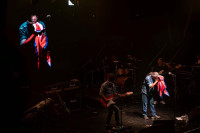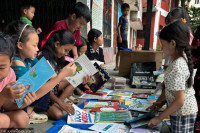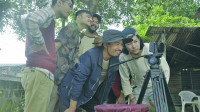Entertainment
Meet the filmmaker who made a documentary out of her solo travel to Upper Dolpo
In 2017, Prasuna Dangol went on a solo trek to Upper Dolpo, an unfamiliar region to many from Kathmandu. As a part of the Solo Women's Travel Challenge, Dangol set out to show how women could travel just as easily as men. The trip in itself was inspiring, she says, but she also managed to make a documentary out of her travels. That documentary, ‘Dolpo Diary’, has gone on to win a number of awards and has introduced Dangol as a fresh new voice in Nepali documentary filmmaking. In a conversation with Sachitra Gurung, Dangol spoke about her experiences travelling to Dolpa, her work process and how she sees the Nepali filmmaking scene.
Sachitra Gurung
In 2017, Prasuna Dangol went on a solo trek to Upper Dolpo, an unfamiliar region to many from Kathmandu. As a part of the Solo Women's Travel Challenge, Dangol set out to show how women could travel just as easily as men. The trip in itself was inspiring, she says, but she also managed to make a documentary out of her travels. That documentary, ‘Dolpo Diary’, has gone on to win a number of awards and has introduced Dangol as a fresh new voice in Nepali documentary filmmaking. In a conversation with Sachitra Gurung, Dangol spoke about her experiences travelling to Dolpa, her work process and how she sees the Nepali filmmaking scene. Excerpts:
- What is the story behind your recent film, ‘Dolpa Diary’?
Dolpa Diary is a narrative of my solo 28-day trek to Upper Dolpo. It’s a journal of my experiences as a traveller. I went to Upper Dolpo as one of the winners of the Solo women travel challenge 2017, organised by Nepali Travellers. But this documentary was totally unplanned. I didn’t start the journey with the motive of making a documentary. I thought maybe I would make a YouTube video out of the footage that I had collected with my phone. But here we are, two years later, with a 24 minute, 24 seconds documentary.
- What challenges did you face filming in Dolpa?
Since I didn't go to Dolpa as a filmmaker, I didn’t have proper equipment. I captured footage with my iPhone 7+, even though I didn’t have easy access to electricity to charge my phone. I tried to save the battery and capture the right moment. Also I faced a language barrier in Upper Dolpo. Everyone spoke Tibetan, only a few spoke Nepali, so I couldn’t communicate well with them. I was constantly torn between exploring the place as a traveller and capturing the scenic beauty as a filmmaker. But I guess the filmmaker in me won at last!
- ‘Dolpa Diary’ won the Best Adventure Mountain Film at the Kathmandu International Mountain Film Festival and the Best Female Director at the 7th Nepal Human Rights International Film Festival 2019, and has been screened in various places inside and outside Nepal. What was that experience like?
I never thought that my story would win awards, but I knew that it would appeal to a lot of people. When Nepali Travellers uploaded my short video, it garnered a lot of views and the response was overwhelming. I would get at least three to four messages daily. That inspired me to make a documentary from my own perspective. I saw it as my responsibility to share the story of Upper Dolpo with other people as it hasn't been explored by many. While researching, I couldn't find much about Upper Dolpo, no itinerary or information was available, unlike other commercial trekking routes. It’s a hidden gem. The people of Dolpa have been nothing but kind and helpful. They played important roles throughout my journey and helped me complete it.
My first screening was at KIMFF. I was very nervous. I was both the filmmaker and the main character in the documentary. I wasn't even sure if people would show up or not. But it was a full house. After the screening, the audience applauded for over a minute. I was lost for words. As a filmmaker, all I want is appreciation for my work and I was thankful to the audience for appreciating my documentary. It was my first time showcasing my work in front of such a huge audience. I was elated winning the Best Adventure Mountain Film whereas winning the Best Female Director award is by far the proudest moment in my life.
- What inspired you to become a filmmaker?
When I was a child, my dad had a Kodak film camera. We only used it for special occasions. I was always eager to see how the photos turned out. The wait for a month to see the final product was exciting for me. Later, I started taking pictures on a digital camera. At that time, I was advised to abandon photography and filmmaking as a hobby, as it wasn't perceived to be a great career prospect. So I applied to study child psychology in the UK. But deep down, I knew that I had a passion for photography and filmmaking. So I applied for the Film and Media course at the Cambridge School of Art. There, the teachers and classmates used to praise my work. My passion grew even more after joining college.
- How do you come up with ideas for your documentaries? What is the thought process behind it? How do you construct the story?
Stories have always fascinated me. If something strikes me, I work on it. First, I decide on an issue then find possible characters. My work involves a lot of research. I try to showcase the unique stories of characters. I believe that every person has an interesting experience or story. I want to uncover their hidden stories. I am just a mediator.
- Which one of your projects is closest to your heart and why?
It has to be Dolpa Diary. I had only covered other people stories until then, but this is my story. There are parts in the documentary where I am vulnerable and emotional. I didn’t want to include those moments in the documentary. But as a filmmaker, I knew that they were very important parts of the documentary. They were the most striking and powerful scenes. I have learned new things about myself through this documentary. It has helped me grow.
- What is your goal as a filmmaker?
For now, I just want to make films and have fun making them. I want to move the audience through my stories.
- What do you think about the future of documentary films in Nepal?
I think it is growing. I am on the selection panel of KIMFF and for the past five years, I have seen a shift in both non-fiction and fiction movies. Back then, there was hardly seven or eight Nepali filmmakers entering the film festival. But now we have more than 50 films submission by Nepali filmmakers. More and more people are interested in and passionate about filmmaking.
- What is it like working as a female documentary filmmaker? And on that note, what was it like traveling alone and shooting a film in a region as remote as Dolpo?
It was a new thing for them and for me as well. I defied social stigma and went there alone. I got a lot of attention so I tried to keep it low key. Also, I had to make certain that people were comfortable being on the camera as it was a new experience for them. One person even questioned about my motives. Everyone wore bakkhu whereas I was wearing trekking gear—he suspected me of being a spy.
- What message are you trying to send through this movie?
Everyone is a wanderer. Maybe not as a traveller but everyone is adventurous in different aspects of life. We need to realise this. We all have fears, small or big, but they're important to recognise. “To have fear is important than to be overly confident, but it shouldn't be to the point that it prevents you from getting out of your comfort zone,” that's a quote from the documentary.
- As a filmmaker, who do you look upto?
I am more interested in non-fiction filmmaking. I look up to Kesang Tseten sir. I love his observational style of documentary filmmaking. He gave me many helpful advice while I was working on my documentary.
- What are you currently busy with? What are your future plans?
I am currently working on small projects, maybe another documentary. Dolpo diary is set to be screened in San Francisco next month. Also I am planning and preparing for a trek to Mt Kailash this June. I am going there during Sakadawa to Kora.
- Your most memorable moment from the trek?
My visit to Shey Gompa. I haven't seen such pure and untouched beauty all my life. It was a big plain field of grass, with different gradients of green and a few cattle grazing. The sun was rising and the birds were chirping. I was alone—standing there in awe—and free, I could do anything. I was the only one in the whole world who witnessed that moment and the moment was just for me. Another most memorable moment has to be when I got lost in the hills alone for five hours. Thankfully I met a grandmother before it got dark. I don’t know what would have happened to me if I hadn’t met her.




 8.12°C Kathmandu
8.12°C Kathmandu








%20(1).jpg&w=300&height=200)

